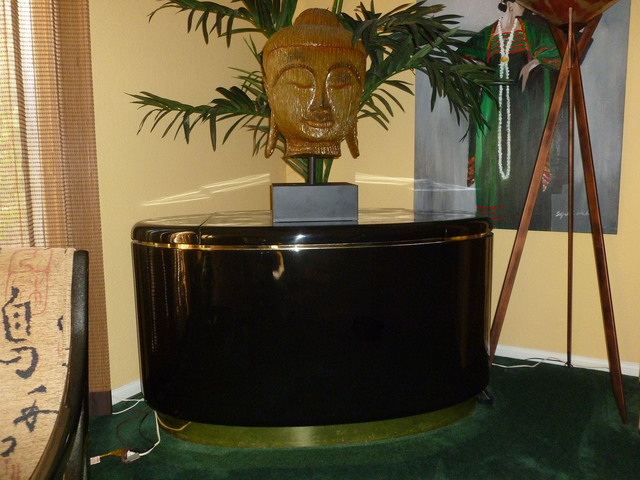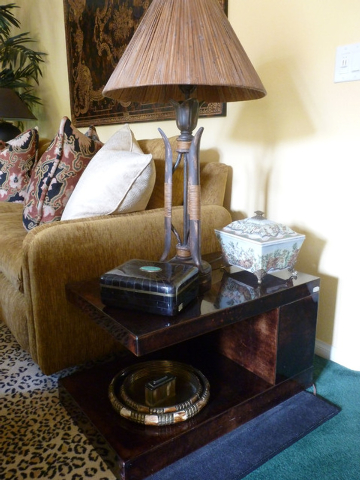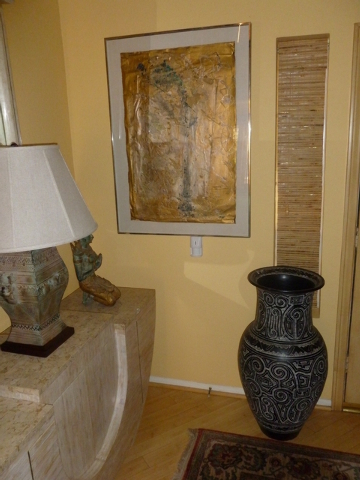Juxtaposition of styles can create a total look to decor
The sun had already begun to set in a brilliant cerulean sky when I suddenly awoke from my reverie. I’d been sitting in my client’s luxurious contemporary great room musing about a corner space that needed something wonderful to complete the room’s overall design statement. It had to be just the right piece. And now I was excited because I’d finally come up with the perfect solution — juxtaposition!
In case you’ve never heard of “juxtaposition” before; let me assure you that no, it’s not a piece of furniture. Well, not exactly. What juxtaposition refers to is best illustrated by examples such as an old trunk placed at the foot of a contemporary bed or a vintage dresser used with new bedside tables. It basically offers what might be referred to as a “harmonious marriage of contradictions” or put another way, the fact of two things being seen or placed together with a contrasting effect. And when used properly, the results can be inspiring.
Still confused? A further example might be the juxtaposition or contrast (if you like) of furniture of one time period used in a building of another era. An antique wardrobe, bed and a chaise displayed in a stark concrete modern structure no doubt creates an interesting look while actually softening the hard-line architecture. The reverse is also true such as introducing contemporary art into a more traditional home. This use of juxtaposition is one that appeals to my own personal design aesthetic. In point of fact, contrasting effects are often used in quality design. That’s to say that unity and diversity is all important in good design.
So go ahead and mix the old with the new. Doing so will help your space take on a personality of its own. In my home there are numerous instances where I’ve done just that. Combining antiques, vintage and Asian pieces with contemporary furniture has been a great way to enrich my décor. But, as far as I’m concerned, there’s a cardinal rule when mixing styles to create a unified but contrasting look. You must remember to go drastically opposite in your choices and not just slightly. Don’t allow yourself to back down and shy away from disparate elements in the fear that they’re just too different. You must believe in your heart, difficult though it may be, that several different styles of furniture can actually create a total look.
There’s another caveat to follow as well when designing with contrast. Although, as I just pointed out, that two styles work best when they’re distinctly unique, you must try hard to see to it that the color pallets as well as the textures still complement one another. That’s because color theory and graphic design become more important when combining two styles that are inherently different.
Following are some basic ideas for mixing and not matching that will help to spruce up any décor:
■ Using end tables of different shapes, sizes and finishes will add great character to your space and are much more visually stimulating that any matched set could ever be.
■ Mix modern chairs with an antique table.
■ Mix wood and aluminum and oriental rugs and Kulims with modern décor.
■ Use two or even three different chairs around a dining room table.
■ Consider an antique table base topped with smooth modern steel.
■ Think about contemporary furniture combined with Asian memorabilia here and there in your home.
■ Antique cupboards used with functional stainless steel workspaces can be united under an ornate chandelier for a wonderful look.
■ Use an antique buffet with an eclectic mix of midcentury modern furniture.
■ A turn of the century French breakfront in a modern kitchen can also be a great way to go.
■ Mix modern molded white plastic chairs and a vintage Kulim rug and/or a Kulim rug used with Japanese/Asian retro pieces.
These are only a handful of suggestions in a sea of wonderful possibilities for mixing the old and the new that will go far in helping you make your house into a home. Designers like myself incorporate a mix of modernity, culture (such as Asian) and vintage all the time because we know that it’s a process that makes a home timeless as opposed to just a time capsule.
In a word, there’s really great beauty to be found in contrasting or juxtaposing objects. For centuries artists have known that the juxtaposition of old and new can actually create an environment that’s respectful of the old while at the same allowing the new to speak for itself and thus enhance and enrich the entire design statement.
And this brings me back to my client’s great room and the revelation I had for that special corner. Into that luxe contemporary space I’ve introduced a tall and very elegant Asian cabinet brilliantly juxtaposed to everything contemporary and voila — the entire space has taken on a new and exciting dimension.
(By the way, there’s actually a store in Newport, Calif., called “Juxtaposition.”)
Stephen Leon is a licensed interior designer and president of Soleil Design; he has been designing and manufacturing custom furniture and cabinetry for more than 25 years. He is president of the Central California/Nevada Chapter of the American Society of Interior Designers and is a certified professional in green residential design. Questions can be sent to soleildesign@cox.net.




















